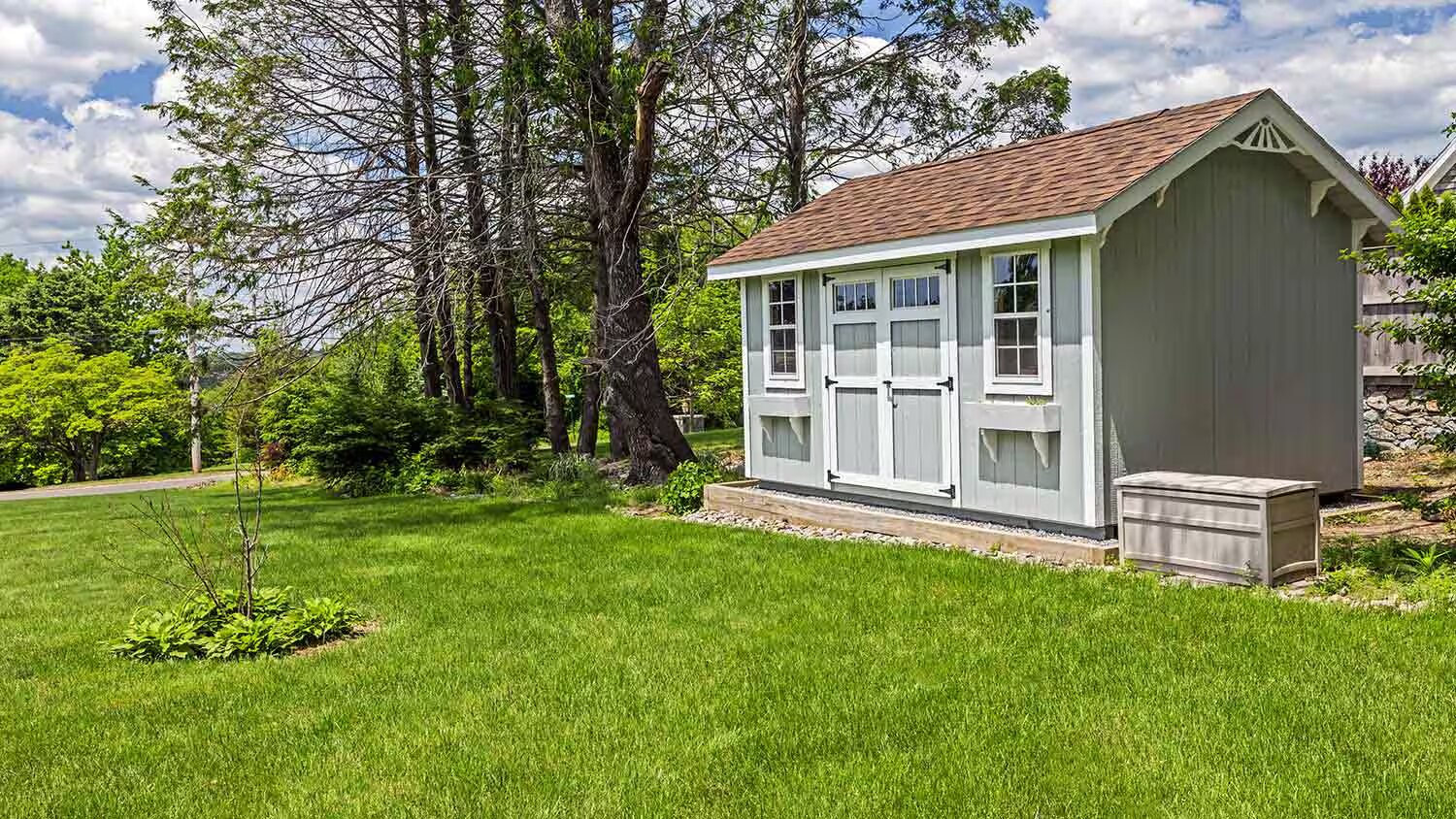Your shed – a haven for tools, equipment, and cherished belongings, sheltered beneath the protective canopy of its roof. Yet, as time marches on, so too does the wear and tear inflicted upon this vital component of your outdoor storage space. The question arises: how often should you replace a shed roof to ensure its continued functionality and structural integrity?
In the realm of roof repair and maintenance, the frequency of shed roof replacement is a topic shrouded in uncertainty for many homeowners. Factors such as weather exposure, material quality, and maintenance practices all play a role in determining the lifespan of a shed roof. Join us on a journey of discovery as we unravel the mysteries surrounding shed roof replacement, empowering you with the knowledge to make informed decisions about your outdoor sanctuary.
If you are looking for professional roofing maintenance services like ours, simply search for us with the keyphrase roofing repairs near me.
1. Understanding Shed Roof Lifespan
The lifespan of a shed roof is influenced by a multitude of factors that collectively determine its durability and longevity. Before determining when to replace your shed roof, it’s crucial to grasp these underlying variables.
Type of Roofing Material
The choice of roofing material significantly impacts the lifespan of your shed roof. Common options include asphalt shingles, metal roofing, wood shakes, and composite materials. Each material has its own set of pros and cons, with some offering greater durability and longevity than others. For instance, metal roofing tends to have a longer lifespan compared to asphalt shingles due to its resistance to weathering and corrosion.
Weather Conditions
Environmental factors play a pivotal role in the degradation of shed roofing materials. Harsh weather elements such as rain, snow, hail, wind, and UV radiation can all contribute to the deterioration of roofing materials over time. For instance, prolonged exposure to UV radiation can cause asphalt shingles to degrade and lose their protective coating, leading to premature ageing and deterioration. Similarly, frequent freeze-thaw cycles in colder climates can cause roofing materials to expand and contract, resulting in cracks and damage.
Installation Quality
The quality of installation also impacts the lifespan of a shed roof. Proper installation techniques ensure that roofing materials are applied correctly and securely, minimising the risk of leaks, damage, and premature failure. Conversely, improper installation can compromise the integrity of the roof system, leading to issues such as water infiltration, sagging, and structural damage.
Maintenance Practices
Regular maintenance is essential for prolonging the lifespan of a shed roof. Routine inspections, cleaning debris, repairing minor damage, and applying protective coatings can all help prevent premature deterioration and extend the life of the roof. Neglecting maintenance tasks can result in the accumulation of debris, moss, algae, and other organic matter, which can trap moisture and accelerate the degradation of roofing materials.
2. Assessing Environmental Factors
Environmental conditions play a significant role in determining the lifespan of a shed roof, as exposure to harsh weather elements can accelerate deterioration and necessitate more frequent replacements.
Rain and Moisture
Excessive rainfall and moisture infiltration can compromise the integrity of roofing materials, leading to issues such as water damage, rot, and mould growth. Proper drainage systems and waterproofing measures are essential for mitigating the impact of rainwater on the shed roof.
Snow and Ice
In colder climates, snow and ice buildup on the roof can pose significant challenges. The weight of accumulated snow can strain the roof structure, leading to sagging and potential collapse. Additionally, freeze-thaw cycles can cause ice dams to form along the roof edges, leading to water infiltration and damage.
Wind
High winds can exert significant force on the shed roof, potentially causing shingles to lift, tear, or become dislodged. Properly securing roofing materials and ensuring adequate fastening is crucial for withstanding wind loads and preventing wind-related damage.
Ultraviolet (UV) Radiation
Exposure to UV radiation from the sun can cause roofing materials to deteriorate over time, leading to fading, cracking, and loss of flexibility. UV-resistant coatings and materials can help mitigate the effects of prolonged sun exposure and extend the lifespan of the shed roof.
By assessing these environmental factors and implementing appropriate measures to mitigate their impact, homeowners can effectively prolong the lifespan of their shed roof and minimise the need for premature replacements.
3. Examining Roofing Material Quality
The choice of roofing material is a critical factor influencing the longevity of your shed roof. While asphalt shingles are a common and budget-friendly option, they tend to have a shorter lifespan compared to more robust alternatives such as metal roofing or architectural shingles. Understanding the characteristics and durability of different roofing materials is essential when evaluating the expected lifespan of your shed roof.
Asphalt shingles, while economical, are susceptible to damage from UV radiation, fluctuating temperatures, and moisture exposure. Over time, they may deteriorate, curl, or lose their granules, leading to leaks and compromised structural integrity. In contrast, metal roofing boasts exceptional durability and longevity, capable of withstanding harsh weather conditions and resisting corrosion. Architectural shingles, with their multi-layered design and enhanced durability, offer an attractive compromise between aesthetics and longevity.
When installing or replacing your shed roof, carefully assess the quality and durability of the chosen roofing material. Consider factors such as weather resistance, impact resistance, and maintenance requirements to ensure optimal performance and longevity. Investing in high-quality roofing materials may incur a higher initial cost but can yield significant savings in the long run by reducing the frequency of replacements and repairs.
4. Implementing Regular Maintenance Practices
Proactive maintenance is paramount to extending the lifespan of your shed roof and minimising the need for premature replacement. By incorporating routine maintenance practices into your schedule, you can identify potential issues early and address them before they escalate into more significant problems.
Regular inspections are the cornerstone of effective roof maintenance. Periodically examine your shed roof for signs of damage, such as cracked or missing shingles, warped or discoloured areas, and sagging sections. Promptly address any issues detected during inspections to prevent them from worsening over time.
Additionally, keep your shed roof free from debris buildup, such as leaves, branches, and moss, which can trap moisture and accelerate roof deterioration. Regularly clean gutters and downspouts to ensure proper drainage and prevent water from pooling on the roof surface.
Applying protective coatings, such as sealants or waterproofing treatments, can further enhance the durability and resilience of your shed roof. These coatings provide an additional layer of defence against UV radiation, moisture penetration, and environmental contaminants, prolonging the lifespan of your roofing material.
By adopting proactive maintenance practices, you can preserve the integrity of your shed roof and maximise its lifespan, ultimately saving time and money on costly repairs and replacements.
5. Signs It’s Time for Replacement
Despite diligent maintenance efforts, there may come a point when replacement becomes necessary to ensure the continued functionality and safety of your shed roof. Recognising the signs indicating that your roof has reached the end of its lifespan is crucial for prompt action and preventive measures.
Common indicators that it’s time to replace your shed roof include:
- Persistent leaks or water infiltration, even after repairs
- Extensive damage or deterioration, such as widespread shingle cracking or curling
- Sagging or drooping sections of the roof structure
- Mold or mildew growth on the roof surface or in the attic
- Excessive granule loss or bald spots on asphalt shingles
- Visible signs of rot or decay in the roof decking or support structure
If you observe any of these warning signs, it’s essential to consult with a professional roofing contractor to assess the extent of the damage and determine the most appropriate course of action. Delaying roof replacement can lead to further structural damage, compromised safety, and increased repair costs in the long run. By recognising the signs of impending roof failure and acting promptly, you can safeguard the integrity of your shed and ensure long-term protection for your belongings.
Conclusion
In conclusion, the frequency with which you should replace your shed roof depends on a myriad of factors, including environmental conditions, roofing material quality, and maintenance practices. By understanding these variables and proactively monitoring the condition of your shed roof, you can make informed decisions about when replacement is necessary to safeguard the integrity of your outdoor sanctuary.
If you are looking for us, simply search for us through the keyphrase: roofers near me.
Ready to ensure the longevity of your shed roof? Contact us today for expert roof repair and maintenance services. From regular inspections to timely replacements, we’ve got you covered. Don’t wait until it’s too late – safeguard your outdoor sanctuary with our professional solutions.




